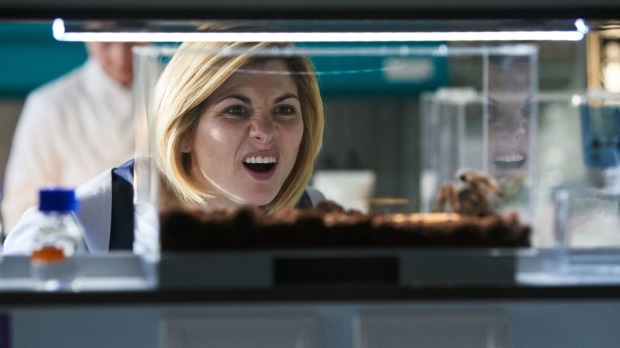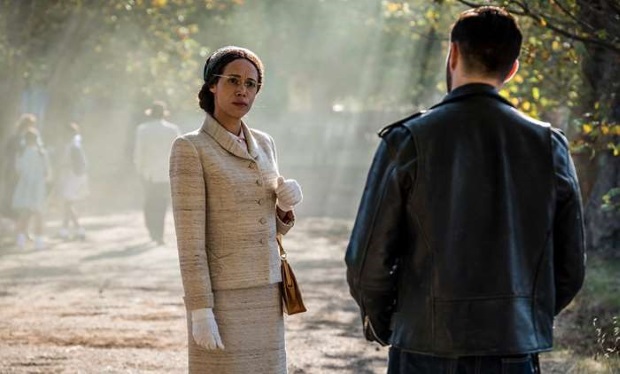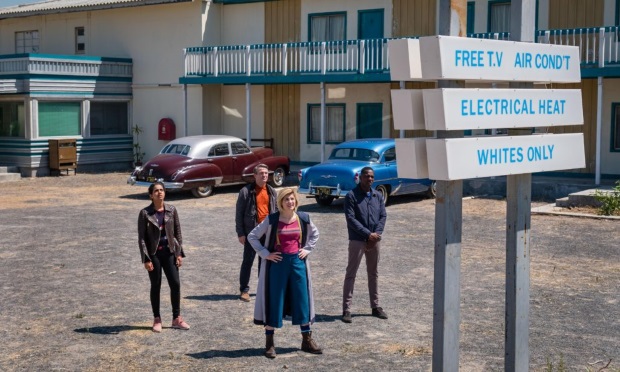Doctor Who series 11: where are the real villains?
Series 11 might be filled with monsters and mutant spiders, but where are the villains that show us who the Doctor really is, asks Zoe?
Warning: contains spoilers for all series 11 episodes to date.
Reviews of the first five episodes of season eleven under Chris Chibnall have found plenty to praise, with one major reservation: where, just where, are the villains? In episode one, The Woman Who Fell To Earth, we had a tooth-ridden blue giant with just one hobby: human hunting. In Ghost Monument, it was hard to tell whether the antagonist was the ego-driven contest runner or the weapon-development that occurred on the planet in its distant past. Rosa introduces us to a time-travelling ex-con white supremacist who at some point managed to kill two-thousand people. (Based on his toothless posturing throughout the episode, it’s hard to imagine how.)
In Arachnids In The UK, there may have been giant, deadly spiders running around, but Chibnall left us in no doubt that the true monster was the one with a human face – Jack Robertson, an up-front Donald Trump caricature, and more broadly, the human tendencies towards corporate greed and despoilment of the natural world. Finally, in the latest episode, The Tsuangra Conundrum, between a energy-sucking gremlin and a ship rigged to explode, it was difficult to say who, or what, the Doctor was actually fighting.
These episodes share the common denominator of being written by showrunner Chris Chibnall. And while his vision for Doctor Who is for many a welcome step back from Moffat’s convoluted plot-lines, the new-look show already seems to be looking for inspiration to Chibnall’s old plotlines. Arachnids In The UK was highly reminiscent of another Doctor Who episode, also written by Chris Chibnall — 42, his 2007 Doctor Who debut. In 42, a failing spaceship is racing on crash-course with the sun. Crewmembers one after another become possessed by a fiery monster, which tells the ship’s captain “It’s your fault.” At the last moment, as the narrative dictates, the Doctor figures it out. The captain had harvested fuel from the sun in order to cut costs, but in fact this sun was alive, and wanted… revenge? Its living matter back? Unclear, but after Martha ejects the fuel, the sun releases its hold on humans and ship, and the day is (sort of) saved, minus the four people who died in the process. 42 and Arachnids In The UK share their central conceit: the antagonist is nature that has been abused — but the true guilt lies with the one who has abused her.

At first glance, this formulation does not seem atypical for Doctor Who. The Beast Below by Steven Moffat, and the Torchwood episode Meat by Catherine Tregenna both feature a large, ancient “monster” that has been captured and abused by the human race. But in both these stories, the beast is largely passive, an object of mingled pity and horror. Ultimately, the beast becomes a metaphor, a stand-in for the Doctor, in the case of The Beast Below, and a stand-in for Jack in Meat. These monsters give us the capacity to better understand and empathise with both series’ non-human leads.
Chibnall is doing something different. His natural monsters are deadly and non-apologetic. They kill people, and they don’t do it nicely. But the crux of both 42 and Arachnids In The UK is that this is not their natural behavior, and they wouldn’t be acting this way if it weren’t for us humans and our frustrating habit of greed. Much of science fiction asks us to empathise with and pity unfortunate scientists, who become victims of their own god-like creative urges. Chibnall, though, has no sympathy for those who despoil and distort the natural world. In fact, he would prefer that we reserve our sympathies for the writhing spider, suffocating under its own weight. It’s a bold move to insist on human accountability, and deserves respect, but the execution thus far has left something to be desired.
Moreover, instead of a standard good/evil binary, Chibnall has set up a binary of the natural vs the unnatural, which is human-induced. This binary is inherently limited and limiting. There’s a reason Doctor Who‘s most famous monsters are the Daleks and the Cybermen – both cyborgs. The cyborg, a mix of organic and machine, complicates the boundary between the natural and unnatural. The Daleks and Cybermen function like robots, but their motivations and flaws are all too recognisably human. They force us to ask ourselves where we draw the line between the human and the non-human, and how much the human can be altered, how much the natural can be distorted, before we deem it monstrous and unrecognisable.
You might say there was a sense of scale and wonder missing so far in Chibnall’s Doctor Who. And that’s because at the end of the day, everything is coming down to humans. The motto of Torchwood, which Chibnall co-produced, is famously, “If it’s alien, it’s ours”, and this pattern has played out in season eleven – it might seem alien, but really the problem is our own, a human problem. In The Tsuangra Conundrum, even the obstacle of an unstoppable, energy-munching mini-monster is overshadowed by an entirely human problem: that a medical transport ship is rigged by the powers-that-be back home to explode at the slightest danger. This tendency is at its height in Rosa, an episode where the enemy is racism, and any sci-fi elements are incidental.

There’s nothing wrong with taking a step-back from the tired ‘aliens plus historical figure’ formula. Aliens plus Dickens! Aliens plus Shakespeare! Aliens plus Robin Hood! By this point, the formula has grown stale. And as other commentators have noted, the ‘pure historical’ was a Classic Who staple long extinct in the Nu Who reboot. But a historical that makes its central characters all human has to deal with the challenge of making all the characters… human. That is, fully-rounded and fleshed-out.
Unfortunately, the time-travelling white supremacist of Rosa did not meet these criteria. It’s understandable that Chibnall and co. didn’t want to portray a white supremacist with any degree of nuance or sympathy, but it was their choice to make their villain a one-dimensional caricature. There are other and better ways to discuss the long-lasting shadow of racism in the United States than by setting up as strawman a bland white supremacist, who can’t do much more than smirk and mutter some propaganda. He’s not an adversary worthy of the Doctor, and the episode seems to know it.
Rosa steals the show, but in her frequent side-eye at the Doctor and companions, I was left wondering what they’re doing in her story. Because Rosa Parks’ story is not one of accidental heroism, of all the right pieces coming together at the right time: “Miss Rosa Parks’ decision to stay in a forward seat was the first move in a planned boycott of the bus company and the city law, a campaign organised long before by the National Association for the Advancement of Colored People (NAACP)”. Short of killing her, our mealy-mouthed white supremacist didn’t have a chance in the world of stopping Rosa Parks and everything she represented. That being the case, the episode was less a gripping story and more an object lesson. There’s a fallacy in placing such a feeble strawman to be batted down: making the villain of a racism episode so impotent doesn’t make racism any less powerful. It’s not without good reason that science-fiction and fantasy so often use monsters to stand-in for ideas. Often, ideas are larger and more boundless than a single person can embody.

Good villains are compelling because they make us question our own values, to ultimately reaffirm them. Villains can fall into many categories — villains we love, villains we love to hate — but at the end of the day, a well-written villain requires some nuance, and some compassion. Right now, Who‘s villains seem more like personifications of an updated seven deadly sins —toxic masculinity, white supremacism, corporate greed — than fully fleshed-out characters.
The Master, Doctor Who‘s strongest human-ish villain, has always mirrored the Doctor. Delgado played the soft-spoken yet sinister gentleman to Pertree’s genteel performance, Simm took the role to the apex of dizzying charm and madness, matching Tennant’s frenetic energy, and Gomez grounded the role with the same unpredictability as Capaldi.
During Eccleston’s run, the Daleks weren’t frightening merely because of their awesome destructive potential or their unrelentingly all-encompassing evil — they terrify in large part because they force the Doctor to confront who he is and what he has become. Without a strong villain to interrogate and hold up a dark mirror to the Doctor, how do we know who she is? In episode four, the thirteenth Doctor admits that she’s still figuring herself out. From the lack of challenging villains so far, the series is still figuring itself out as well.